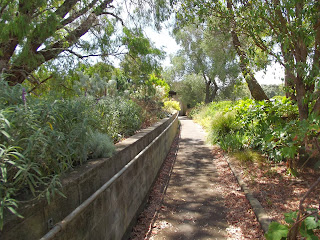Te Kainga Marire means ‘peaceful encampment’ in Maori.
This garden has been created on a private property in the middle of New
Plymouth, a city of 53,000 on the Tasman Sea coast of the Northern Island of
New Zealand, which is part of the Taranaki region.
The owners of the property, Valda Poletti and Dave
Clarkson, began work on this garden back in 1972, when it was pretty much
wasteland. Over the years they planted many native trees and bushes, being careful to
follow the natural association of plants in the wild as much as possible. The
main goal was to make this place a ‘bird-friendly’ garden.
After all those years of efforts they have succeeded,
proof of which is the return in the area of the ‘tui’ bird, a large forest
dwelling honey eater native to New Zealand (photos below). Another ‘proof’ is
the recognition bestowed to the garden by the Royal New Zealand Institute of Horticulture Gardens Trust. This trust provides a list of private and public
gardens to visit, which are rated using a star system, six stars being the
highest rating. Te Kainga Marire holds that prestigious rating and is listed as
a ‘garden of international significance’ by the trust.
Here are some photos of this remarkable garden:
The hebe plant, a New Zealand native, is grown in various areas of the world now as an ornamental for its showy flowers that attract butterflies. There's also a Hebe Society which promotes the cultivation of hebes and other native plants in New Zealand.
The Marlborough rock daisy (below) is a native of the South Island Marlborough region, especially in the Kaikoura area. They are now used as an ornamental in gardens as well.
The tree on the left is called 'titoki', a New Zealand native short tree (up to 9 m high. It is among the most planted native tree in that country. The fruit of this tree is a favorite food of the New Zealand wood pigeon (photo below).
The garden co-owner/creator, Valda Poletti, is showing a nikau palm, the only palm tree native to New Zealand.
The fruit of that palm are another favorite food of the wood pigeon. The tree had many uses with the Maoris - food, food wrapping, basket and floor weaving, etc.
The pomme reinette du Canada (Golden Russet apple) below is, in spite of its French name, a cultivar from England dating from the 1800s. In this garden the tree is trained along a timber fence using the espalier method.
 This mandarin tree grows in a natural setting with New Zealand wind grass (anemanthele lessoniana) in the foreground. This type of grass (zones 8-10) is popular with garden designers in North America.
This mandarin tree grows in a natural setting with New Zealand wind grass (anemanthele lessoniana) in the foreground. This type of grass (zones 8-10) is popular with garden designers in North America.
The rangiora (above), is a small bushy tree endemic to New Zealand. Also called the 'Bushman's friend' because if its large leaves with a soft furry underside with antiseptic properties. It also had a variety of medicinal uses with the Maoris.
FERNS IN NEW ZEALAND
For a country with a temperate climate, New Zealand has a very large number of fern species, around 200. Among them is the tree fern, which can grow up to 20 meters high depending on the species.
The photo below shows a 'Rough Tree Fern' (dicksonia squarrosa), which is growing near - and above - the garden creator's home. This tree fern is endemic to New Zealand and common. The trunks were used as fence posts by Maoris. For people unaccustomed to see such a giant fern, it is quite an impressive sight!

This one below is the Golden Tree Fern (dicksonia fibrosa). Both species can reach heights of up to 6 meters.

This welcoming sign above describes the main features of Te Kainga Marire.
The tui bird (photos above) is attracted the same way we attract hummingbirds here in PEI - with a feeder (shown at the bottom of the photos) filled with a specially prepared nectar.
However this is not the only bird attracted to those feeders. The wood pigeon (below) also comes for a sip from time to time.
Te Kainga Marire has been featured in 2008 in a BBC televised series entitled ‘Around the World in 80 gardens’, by Monty Don. Here’s the link to this report: http://www.youtube.com/watch?v=e6rTZbVjYbo
(article and photos by Denise Motard)


 .
.
















